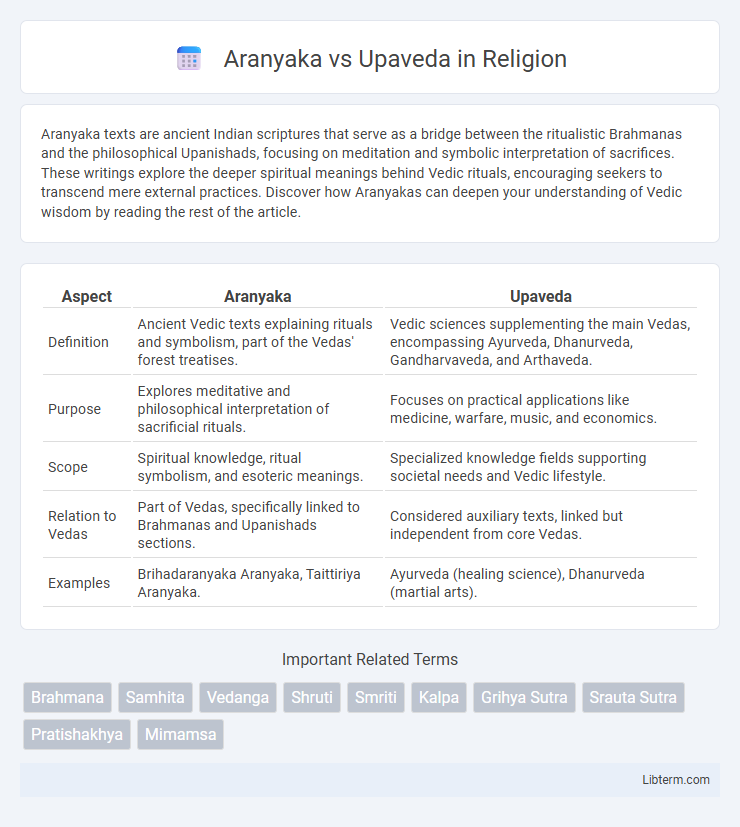Aranyaka texts are ancient Indian scriptures that serve as a bridge between the ritualistic Brahmanas and the philosophical Upanishads, focusing on meditation and symbolic interpretation of sacrifices. These writings explore the deeper spiritual meanings behind Vedic rituals, encouraging seekers to transcend mere external practices. Discover how Aranyakas can deepen your understanding of Vedic wisdom by reading the rest of the article.
Table of Comparison
| Aspect | Aranyaka | Upaveda |
|---|---|---|
| Definition | Ancient Vedic texts explaining rituals and symbolism, part of the Vedas' forest treatises. | Vedic sciences supplementing the main Vedas, encompassing Ayurveda, Dhanurveda, Gandharvaveda, and Arthaveda. |
| Purpose | Explores meditative and philosophical interpretation of sacrificial rituals. | Focuses on practical applications like medicine, warfare, music, and economics. |
| Scope | Spiritual knowledge, ritual symbolism, and esoteric meanings. | Specialized knowledge fields supporting societal needs and Vedic lifestyle. |
| Relation to Vedas | Part of Vedas, specifically linked to Brahmanas and Upanishads sections. | Considered auxiliary texts, linked but independent from core Vedas. |
| Examples | Brihadaranyaka Aranyaka, Taittiriya Aranyaka. | Ayurveda (healing science), Dhanurveda (martial arts). |
Introduction to Aranyaka and Upaveda
Aranyakas are ancient Vedic texts that serve as a bridge between the ritualistic Brahmanas and the philosophical Upanishads, focusing on the meaning and symbolism of sacrificial rituals performed in forest settings. Upavedas are supplementary Vedic sciences, each linked to a specific Veda, covering fields like Ayurveda (medicine), Dhanurveda (martial arts), Gandharvaveda (music), and Arthashastra (economics and politics). While Aranyakas delve into the esoteric interpretations of rituals and spiritual practices, Upavedas extend Vedic knowledge into practical and specialized disciplines.
Historical Background of Aranyaka
Aranyakas, composed between 900 and 700 BCE, serve as ritualistic texts bridging the Brahmanas and Upanishads within the Vedic literature. These ancient scriptures primarily address the philosophical aspects and meditative practices of sacrifices conducted in forest hermitages, reflecting a transitional phase in Vedic tradition. Upavedas, considered auxiliary sciences linked to the Vedas, emerged later focusing on specialized knowledge such as Ayurveda, Dhanurveda, and Gandharvaveda, contrasting the Aranyakas' ritualistic and spiritual discourse.
Origins and Development of Upaveda
Aranyakas are ancient Vedic texts that serve as a bridge between the ritualistic Brahmanas and the philosophical Upanishads, primarily focused on forest rituals and meditative practices. The Upavedas, considered supplementary Vedic sciences, developed subsequently to extend the practical applications of Vedic knowledge into specialized fields like Ayurveda, Dhanurveda (archery), Gandharvaveda (music), and Sthapatyaveda (architecture). Originating from the core Vedic traditions, the Upavedas evolved as systematic treatises to preserve and propagate applied sciences closely linked to spiritual and societal needs in ancient Indian culture.
Core Purpose of Aranyaka Texts
Aranyaka texts primarily serve as ritual manuals and philosophical guides designed for forest-dwelling ascetics, emphasizing meditative practices and symbolic interpretations of Vedic rituals. They bridge the transition between the ritualistic focus of the Brahmanas and the philosophical inquiries found in the Upanishads, promoting internalization of sacrificial rites. Unlike the Upavedas, which are technical treatises on auxiliary sciences like medicine or music, Aranyakas focus on spiritual insight and the inner meanings of ceremonies.
Main Branches of Upaveda
Aranyakas serve as ritualistic and meditative texts that explain the esoteric meanings behind Vedic sacrifices, primarily linked to the Vedas. Upavedas, considered auxiliary Vedic sciences, consist of four main branches: Ayurveda (medicine), Dhanurveda (martial arts and warfare), Gandharvaveda (music and arts), and Sthapatyaveda (architecture and engineering). Each Upaveda complements the primary Vedas by applying Vedic knowledge to practical disciplines fundamental to ancient Indian society.
Key Philosophical Differences
Aranyakas primarily focus on ritualistic interpretations and meditations linked with sacrifices, emphasizing symbolic meanings and philosophical reflections on Vedic rituals. Upavedas, considered auxiliary texts, extend beyond ritual to specialized knowledge fields such as Ayurveda (medicine), Dhanurveda (archery), and Gandharvaveda (music), integrating practical applications with spiritual insights. The key philosophical difference lies in Aranyakas exploring metaphysical truths through ritual symbolism, while Upavedas emphasize functional disciplines supporting worldly and spiritual well-being.
Literary Structure and Style
Aranyakas primarily exhibit a meditative and ritualistic literary structure, blending prose and poetic hymns with a focus on symbolic interpretations of Vedic ceremonies. Upavedas, comprising Ayurveda, Dhanurveda, Gandharvaveda, and Arthaveda, present a more specialized and technical style, organized systematically to convey practical knowledge in medicine, warfare, music, and economics. While Aranyakas emphasize allegorical narrative and philosophical exposition, Upavedas prioritize clarity, instruction, and application within their respective disciplines.
Influences on Hindu Ritual Practices
Aranyakas and Upavedas significantly influence Hindu ritual practices through distinct approaches; Aranyakas provide philosophical explanations and meditative insights related to Vedic rituals, emphasizing internalization and symbolic meanings behind sacrificial ceremonies. Upavedas, comprising disciplines like Ayurveda, Dhanurveda, Gandharvaveda, and Arthashastra, extend ritual practices into specialized areas such as healing, martial arts, music, and governance, integrating ritualistic elements with practical applications. This dual influence ensures Hindu rituals are both spiritually profound and practically relevant across various aspects of life.
Comparative Significance in Vedic Literature
Aranyakas serve as transitional texts between the ritualistic Brahmanas and the philosophical Upanishads, focusing on the esoteric interpretation of Vedic rituals and meditations meant for forest-dwelling hermits. Upavedas, classified as auxiliary disciplines, encompass specialized knowledge such as Ayurveda (medicine), Dhanurveda (archery), Gandharvaveda (music), and Sthapatyaveda (architecture), extending the practical applications of Vedic wisdom beyond spiritual rites. The comparative significance lies in Aranyakas deepening ritual symbolism and spiritual introspection, while Upavedas broaden the Vedic corpus through systematic, applied sciences essential for societal functions.
Modern Relevance of Aranyaka and Upaveda
Aranyakas, as ancient Vedic texts linked to meditative rituals and forest hermitages, offer modern relevance through their emphasis on inner spiritual experience and ecological harmony, inspiring contemporary practices in mindfulness and environmental ethics. Upavedas, specialized supplementary Vedic disciplines such as Ayurveda, Dhanurveda, Gandharvaveda, and Sthapatyaveda, contribute significantly to modern holistic health, martial arts, music therapy, and sustainable architecture. Both Aranyakas and Upavedas integrate traditional wisdom with practical applications, supporting contemporary well-being and cultural preservation efforts.
Aranyaka Infographic

 libterm.com
libterm.com